Mineral and Rock Abundances
| None (0) | Minor (1) | Few (2) | Common (3) | Frequent (4) | Major (5) | Very Dominant (6) |
| 0% | 0-5% | 5-15% | 15-30 % | 30-50% | 50-70% | 70-100% |
| Name | Cal. | Quartz | Feldspar | Pyroxene | Amphibole | Opaques | Olivine | Biotite | Muscovite | Epidote | Garnet/ Spinel | Ig./Met. Rocks | Sed. Rocks | Grog | Lithics/ Region |
|---|---|---|---|---|---|---|---|---|---|---|---|---|---|---|---|
| Max | 6 | 2 | 2 | 2 | 0 | 1 | 0 | 0 | 0 | 0 | 0 | 0 | 0 | 0 | na |
| Min | 5 | 0 | 1 | 0 | 0 | 1 | 0 | 0 | 0 | 0 | 0 | 0 | 0 | 0 | PNG |
Representative slides:
| Slide | Site | Possible Origin | Cal. | Quartz | Feldspar | Pyroxene | Amphibole | Opaques | Olivine | Biotite | Muscovite | Epidote | Garnet/ Spinel | Ig./Met. Rocks | Sed. Rocks | Grog | Lithics |
|---|---|---|---|---|---|---|---|---|---|---|---|---|---|---|---|---|---|
| IL_1_93 | Gitua (Png) | Gitua | 6 | 0 | 1 | 1 | 0 | 1 | 0 | 0 | 0 | 0 | 0 | 0 | 0 | 0 | na |
| IL_1_95 | Nambariwa (Png) | Nambariwa | 5 | 0 | 2 | 2 | 0 | 1 | 0 | 0 | 0 | 0 | 0 | 0 | 0 | 0 | na |
| IL_1_58 | Sio (Png) | Huon | 6 | 2 | 2 | 0 | 0 | 1 | 0 | 0 | 0 | 0 | 0 | 0 | 0 | 0 | na |
| IL_2_19 | Malai (Malai) | Huon | 6 | 0 | 2 | 1 | 0 | 1 | 0 | 0 | 0 | 0 | 0 | 0 | 0 | 0 | na |
| IL_2_25 | Malai (Malai) | Huon | 6 | 0 | 1 | 2 | 0 | 1 | 0 | 0 | 0 | 0 | 0 | 0 | 0 | 0 | na |
| IL_1_21 | Sio (Png) | Madang | 5 | 2 | 2 | 0 | 0 | 1 | 0 | 0 | 0 | 0 | 0 | 0 | 0 | 0 | na |
IL_1_93
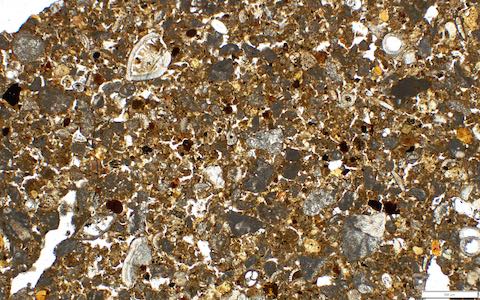
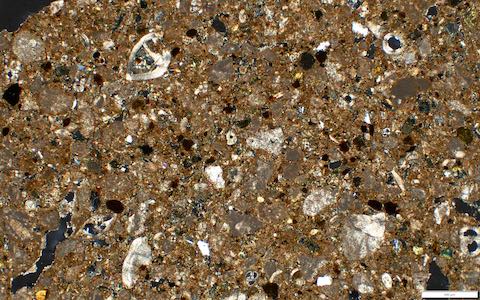
CAUTION: Section less than 30microns. Kukumei clay used by potters. Consists predominately of shelly fragments about 0.2 mm across. Some of the shelly fragments show cellular structure and are clearly corals and molluscs. There is minor feldspar and pyroxene grains, less than 0.2 mm across. Subrounded opaques, less than 1%. And a trace of collophane.
IL_1_95
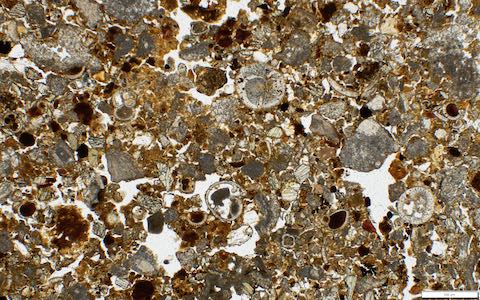
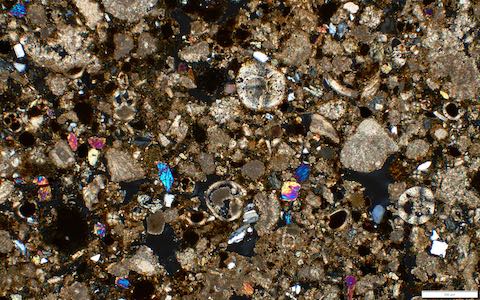
CAUTION: Section less than 30microns. Nambariwa clay. Consists of shelly fragments (more than 50%) of different sizes up to 2 mm. Some of the fragments show excellent cellular structure indicating the presence of coral, gastropods and bivalves. Other shelly fragments consist of very fine grained carbonate. Pyroxene grains (<5%) are colourless, angular and less than 0.2 mm across. There is a trace of spinel, minor angular feldspar (less than 0.2 mm across) and brown clay.
IL_1_58
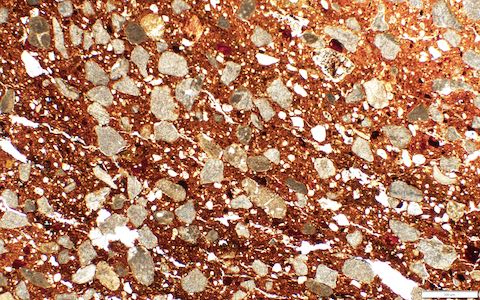
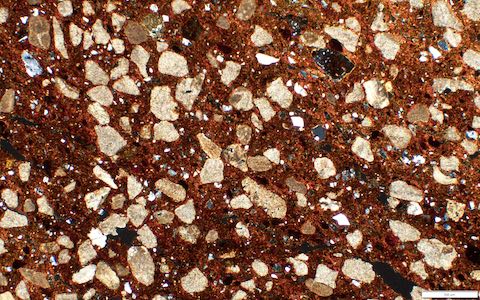
Madang style sherd. CAUTION: Section less than 30 microns. Shelly fragments are generally subrounded and about 0.2 mm across. Plagioclase grains are about 0.1 mm in diameter and there are abundant small quartz grains widely scattered through the sherd. Opaque minerals are minor and there are some red to black ferruginized clasts. Pyroxene is rare.
IL_2_19
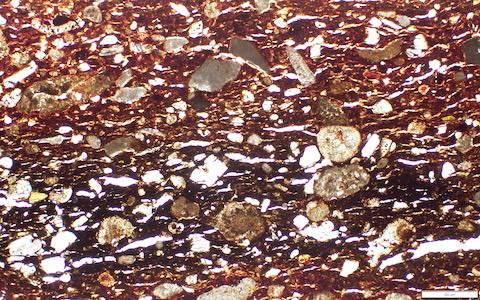
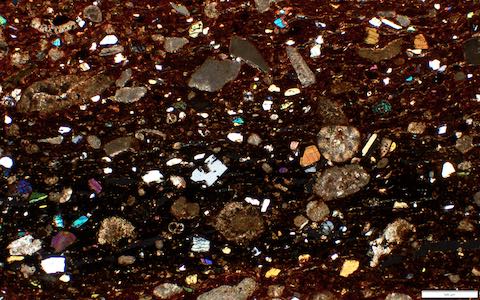
Sio style sherd. CAUTION: Section less than 30microns. Shelly fragments are generally subrounded and less than 1 mm in diameter. Pyroxene grains are up to 0.3 mm in length. Plagioclase occurs as angular grains less than 0.2 mm in length. There is also accessory iron oxides and red clay pellets. The clay is red brown
IL_2_25
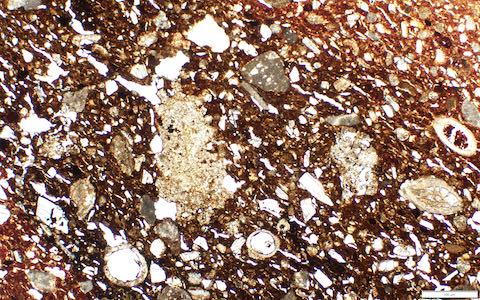
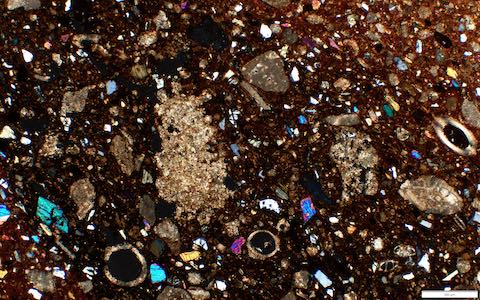
Sio style sherd. CAUTION: Section less than 30microns. Shelly fragments, are up to 1 mm in length. Pyroxene crystals, plagioclase crystals range in size from <0.1 up to 0.2 mm in length. There is also accessory iron oxide grains and the clay is red brown.
IL_1_21
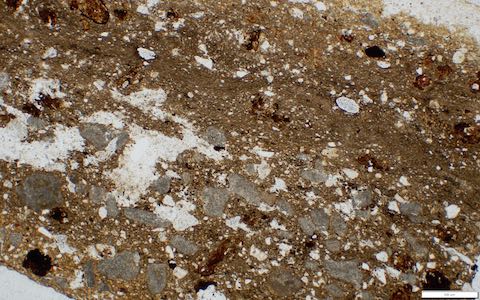
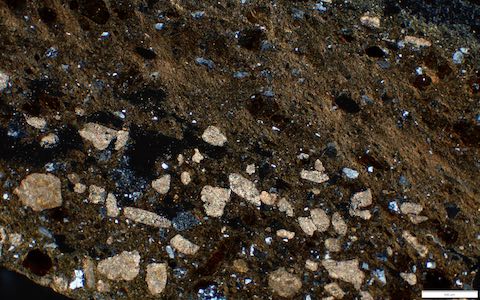
Madang style. CAUTION: Section less than 30microns. Subrounded shelly fragments up to 0.3 mm in diameter make up less than 10%. Quartz, chert and feldspar grains (<10%) are all less than 0.2 mm in length. There are some dark red-black ferruginized clasts up to 0.5 mm and the clay is brown.